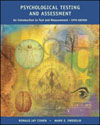Choose the best answer to each question based on material presented in Psychological Testing and Assessment, 5th Edition by Ronald Cohen and Mark Swerdlik.
These questions only sample material from the chapter; there is much more to know than sampled here.
 |
1 |  | 
Stated succinctly, test validity refers to a judgment concerning |
|  | A) | How consistent a test measures what it purports to measure. |
|  | B) | Why the test should or should not be used for a specific purpose. |
|  | C) | How well a test measures what it purports to measure. |
|  | D) | How sound the evidence is that supports conclusions from it. |
 |
 |
2 |  | 
A local validation study is a study |
|  | A) | conducted by test-takers from a particular locality or community. |
|  | B) | conducted by test users who plans to alter a test in some way. |
|  | C) | undertaken by certified test developers from a specific locality. |
|  | D) | undertaken by the original test publisher for any purpose. |
 |
 |
3 |  | 
Which is NOT a traditional component of the so-called Trinitarian view of validity? |
|  | A) | Validity. |
|  | B) | Content validity. |
|  | C) | Criterion-related validity. |
|  | D) | Construct validity. |
 |
 |
4 |  | 
It has been characterized as the "Rodney Dangerfield of psychometric variables." It is |
|  | A) | odd-even reliability. |
|  | B) | marital satisfaction. |
|  | C) | variance. |
|  | D) | face validity. |
 |
 |
5 |  | 
A job applicant takes a company-administered test for employment and then questions the relevance to the job of certain test items. Stated another way, the applicant is expressing concern about the test's |
|  | A) | incremental validity. |
|  | B) | content validity. |
|  | C) | factor loadings. |
|  | D) | all of the above. |
 |
 |
6 |  | 
History tests in different regions of the world may |
|  | A) | be used to illustrate that there are certain cultural absolutes. |
|  | B) | have the same questions but different answers keyed correct. |
|  | C) | be used to illustrate the irrelevancy of culture to historical fact. |
|  | D) | be written in different languages but have similar content. |
 |
 |
7 |  | 
Which does NOT belong? |
|  | A) | Criterion-related validity. |
|  | B) | Content validity. |
|  | C) | Concurrent validity. |
|  | D) | Predictive validity. |
 |
 |
8 |  | 
When a criterion measure is itself based, at least in part, on predictor measures, what is said to exist is |
|  | A) | criterion-related validity. |
|  | B) | predictive validity. |
|  | C) | criterion contamination. |
|  | D) | concurrent validity. |
 |
 |
9 |  | 
The proportion of people accurately identified by a test as having a particular trait, behavior, characteristic, or attribute is referred to as a |
|  | A) | hit rate. |
|  | B) | accuracy rate. |
|  | C) | trait rate. |
|  | D) | all of the above. |
 |
 |
10 |  | 
In order to establish the construct validity of a test, evidence could be gathered indicating that |
|  | A) | the test measures a single concept. |
|  | B) | expected changes in test performance occur over time. |
|  | C) | expected changes in test performance occur as a result of experience. |
|  | D) | all of the above |
 |
 |
11 |  | 
Discriminant evidence of construct validity is otherwise known as |
|  | A) | discriminant validity. |
|  | B) | convergent validity. |
|  | C) | predictive validity. |
|  | D) | factor analytic validity. |
 |
 |
12 |  | 
With regard to the issues of test validity, fairness, and bias |
|  | A) | it is possible for a test to be valid yet used unfairly. |
|  | B) | it is possible for a test to be biased and used unfairly. |
|  | C) | test bias systematically prevents accurate, impartial measurement. |
|  | D) | all of the above. |
 |
 |
13 |  | 
An instructor evidences a tendency not to fail any student in the class, but not to give any grades of A either. This instructor may be evidencing a |
|  | A) | leniency tendency error. |
|  | B) | severity error. |
|  | C) | central tendency error. |
|  | D) | all of the above |
 |
 |
14 |  | 
Your brother did very well in Mrs. Jones's class. Now you are in her class and can't seem to do any wrong. You are probably the benefit of |
|  | A) | a generosity error. |
|  | B) | a halo effect. |
|  | C) | a clerical error. |
|  | D) | the Mel Gibson effect. |
 |
 |
15 |  | 
With regard to adjusting test scores by group membership, Gottfredson has argued that |
|  | A) | such adjustments must be made if society is to progress. |
|  | B) | tools of measurement must not be blamed for group differences. |
|  | C) | adverse impact must be prevented by means of differential scoring. |
|  | D) | all of the above. |
 |



 2002 McGraw-Hill Higher Education
2002 McGraw-Hill Higher Education